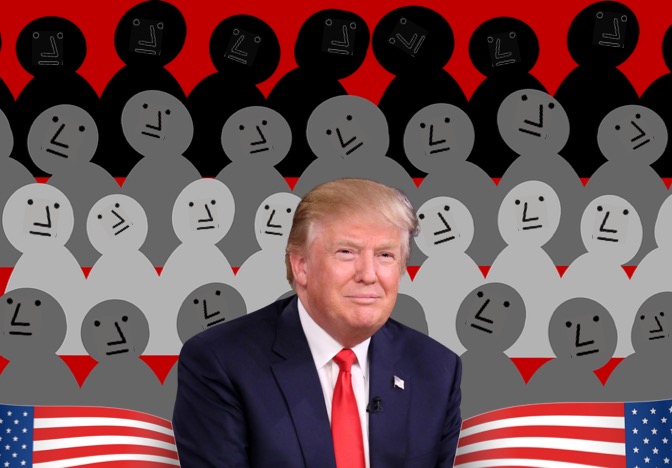Through dignity and subsidiarity, America can prevail with more than rough justice.
What the Right Must Learn From Trump

To save the Republic, the Right must reorient itself to fight multiculturalism.
Tom Klingenstein has written a powerful essay that perfectly captures the essence of the existential conflict raging in America today. What was at stake in the 2016 election, and what is stake today and for the foreseeable future, is not a political contest between liberalism and conservatism but a “choice between two mutually exclusive regimes: multiculturalism and America.” Klingenstein defines multiculturalism as a project synonymous with identity politics, political correctness, and a continual emphasis on group conflict based on the centrality of race, ethnicity, and gender.
Most importantly, multiculturalism or identity politics is hostile to America, its people, and their beliefs. It is not only philosophically and morally opposed to the way the Founders and Lincoln understood our nation, but also to what our citizens believe and how they actually live in their day-to-day lives. The proponents of identity politics seek to “fundamentally transform” a way of life that they do not like. Trump won in 2016 because he (unlike other Republican leaders) explicitly opposed the “fundamental transformation” of America and openly repudiated the core assumptions of its adherents.
Multiculturalism’s Two Foundations
Klingenstein poses the crucial question: “What is to be learned from Trumpism that might inform the future of the conservative movement?”
Let us start with the premise that multiculturalism rests on two parallel foundations: the administrative state and the cultural leviathan. Readers of Claremont publications are familiar with the masterful work of John Marini and his well-developed concept of the administrative state. To wit, a bureaucratic-regulatory extra-constitutional “fourth branch of government” in which unelected and unaccountable officials exercise legislative, executive, and sometimes, judicial authority, outside of (and antagonistic to) our constitutional democratic framework.
The authority of the administrative state does not rest on raw power alone; like any political regime, it needs moral and intellectual legitimacy. This moral-intellectual legitimacy is rooted in a system of principles, values, mores, norms, and cultural habits that together constitute what Antonio Gramsci called ideological hegemony. What could be described as the “cultural leviathan” provides moral-intellectual legitimacy to the administrative state.
The cultural leviathan consists of the vast network of universities, mainstream media, corporate human resources departments, public schools, and the entertainment industry that promotes, creates, and polices, norms and opinions. The cultural leviathan bolsters the moral-intellectual legitimacy of the administrative state by exercising ideological hegemony through the advancement of what is euphemistically called “diversity.”
Coercive Diversity
The concept of “diversity” is at the center of the nexus between the administrative state and the cultural leviathan. It is at the core of what Klingenstein defines as multiculturalism or identity politics or political correctness, the lodestar of the entire progressive liberal project of the 21st century.
“Diversity” does not mean what it used to mean—the traditional pluralism that is the result of differing interests, ideas, talents, and opportunities in a free society. Today “diversity” means that society is divided into adversarial ethnic-racial, gender, and sexually orientated groups. There are the dominant oppressor groups (males, whites, Christians, heterosexuals, native-born English speakers) and the marginalized and oppressed victim groups (women, ethnic and linguistic minorities, LGBT, illegal immigrants).
One purpose of diversity ideology is to instill specific group “consciousness” in the victim groups in order that they will be alert to their “oppression” by the dominant groups. At its most benign, the diversity project advances group parity, meaning that the victim groups should be proportionally represented in all sectors of society. For example, gender and ethnic parity would mean that if 50% of the population were women and 10% Asian American, then 50% of all accountants, engineers, military officers, US Senators, etc. should be women, and 10 % should be Asian American. If not, there would be a problem of “underrepresentation.”
This type of group proportionalism, or the gender and ethnic parity which is the implicit (and sometimes explicit) end-goal of the diversity project, cannot be realized in a free society. It is impossible without government and societal coercion. The promoters of “diversity” favor what is more honestly called “coercive diversity.” We know why they don’t use that term. Why don’t we start using it?
A Question of Justice
At the macro-level of grand strategy the deconstruction of the administrative state and the de-legitimization of the cultural leviathan should be the overarching goal of the Right after Trump.
Since both these two major bulwarks of coercive diversity are firmly entrenched in American civic life the conservativism of the future (as I have argued) needs to be more “disruptive.” We are not defending the status quo. Therefore, moderate policies and a restrained “conservative disposition” are not an adequate mind-set for the task ahead.
Klingenstein argues—rightfully, in my view—that “The [2016] election was fought over the meaning of America.” Trump’s “entire campaign was a defense of America.” He “alone, categorically and brazenly reject[ed] the morality of multiculturalism [coercive diversity.]” He offered in its place something closer to the traditional American understanding of “right and wrong,” of justice. What we face in the American body politic today, Klingenstein notes, “as in the 1850s” is two very “different concepts of justice” which are “mutually exclusive.”
The traditional American concept of justice as understood by the Founders, Lincoln, and the mid-20th century civil rights leaders was based on the natural rights theory of human equality as expressed in the Declaration of Independence. In the political sphere this means equality of individual citizenship. No American citizen is inherently inferior or superior to any other American citizen.
In the “multicultural” (coercive diversity) framework, what matters is not the equality of individual American citizens (or, for that matter, even citizenship itself), but the ethnic, racial, gender, linguistic group that one belongs to. In the “diversity” context “justice” means some are more equal than others in employment, in college admission, in federal contracts, and congressional redistricting. These un-American inequalities are implemented by the administrative state and blessed by the secular clerisy of the cultural leviathan. The two concepts of justice (multiculturalism vs. America) are, of course, totally incompatible. In the end, one or the other will triumph. As Klingenstein reminds us, “A house divided against itself cannot stand.”
Unfortunately many conservatives and Republicans have failed to grasp the existential nature of the conflict that we are in. They do not see the big picture: the connectedness—yes, the intersectionality—of the diversity-progressive assault on all aspects of the American regime. Instead, some conservatives are often involved in virtue signaling and pandering to the cultural leviathan, as the ordeal around the students at Covington Catholic recently revealed.
Conservatism needs to be “re-oriented.” It needs to focus on this one big challenge to the American way of life. Klingenstein writes “opposition to multiculturalism” should be made “the center of our movement” and “provide the conceptual frame for interpreting events.” All of this is good advice at the level of grand strategy.
The MENA Example
Let us examine a particular “front” of what the Claremont Institute’s Angelo Codevilla called our “cold civil war.”
In 1977, the U.S. Census created five ethnic categories that established an official diversity paradigm within American administrative and bureaucratic law: Spanish surname persons who became Hispanics or Latinos; Blacks later called African Americans; American Indians (later called Native Americans) and Alaskan natives; Asians and Pacific Islanders; and Whites. All of these artificial categories consist of people from widely divergent cultural backgrounds.
Nevertheless, this categorization serves the purposes of the diversity project by promoting victim group consciousness, fostering an ethnic-racial spoils system in terms of employment, school admissions, contracts, and encouraging the use of “disparate impact” law suits when some ethnic groups appear to be “underrepresented” in different occupations. As Thomas Sowell has pointed out, different ethnic groups have always been either “underrepresented” or “overrepresented” in different occupations in every society that has ever existed in human history—a fact even perpetual litigation will find it hard to change.
Near the end of the Obama administration, career civil servants in the Census Bureau, along with a federal “stakeholders” advisory committee composed largely of special-interest activists, proposed the creation of another artificial multi-ethnic group that would become a “protected class,” an official victim group eligible for a range of benefits and government funding. The proposed group was to be called MENA, for Middle East/North African. It would consist of Americans from widely diverse backgrounds: Iranians, Arabs, Turks, Lebanese, but also Somalis and Sudanese from sub-Saharan Africa. Covered by this new “protected class” would be many Muslims and Middle East Christians, but Israelis were specifically not included.
A streamed 2015 meeting of Census bureaucrats and stakeholders is particularly revealing of the process behind this classification. One sees the Palestinian-American activist, Linda Sarsour, a strident anti-Israeli figure, touting MENA as providing benefits for another “marginalized” group. Sarsour’s comments are echoed by Khaled Beydoun, a law professor and critical race theorist. He noted a “cascading effect,” stating the MENA classification would apply to employment and college admissions and, therefore, members of this “protected class” would see its concrete benefits. Another law professor declared “I hate using the term ‘melting pot.’” She worried that after several generations the MENA category would “melt away” and these citizens might just consider themselves as Americans.
One of the federal Census bureaucrats in attendance, Roberto Ramirez, head of the Census’s Ethnic and Ancestry Statistics branch reinforced the advocacy promoted by the stakeholders. The Census stakeholders meeting of 2015 is one small example of the symbiotic relationship linking the administrative state and the cultural leviathan in the promotion of “diversity.”
Marini and others point out that the moral basis for the administrative state in America today is its reliance on expertise and knowledge. Its officials portray themselves as impartial experts, with deep subject knowledge. And this is the administrative state’s claim to legitimacy. But the MENA process strongly suggests stakeholders like Linda Sarsour and Khaled Beydoun, and the federal officials involved, are inclined to act more as ideologues than experts.
In the end, the creation of MENA was blocked by the new Trump administration. But on our current bureaucratic path, the initiative is sure to reappear in the future. And this is but one example of what is to come. So what is to be done?
Take the Offensive
Along the lines of the strategy sketched out by Klingenstein, conservatives should mount an offensive against identity politics in the name of an American understanding of justice and the natural rights concept of the equality of individual American citizens. A full-blown campaign of this sort would push to abolish all five pan-ethnic census categories and work to disentangle federal law from the official language of “protected classes,” “disparate impact,” “underrepresentation,” and the like.
One example of the impact of this kind of effort is census-taking. For about 150 years the Census has asked about one’s birth country and one’s parents’ birth country. There is no reason not to continue this practice. If scholars want to use this data fine, but it should not be the business of the government to discriminate on the basis of artificial multiethnic identities. The Census issue is, of course, only one sector in the broad existential conflict between the identify politics project and the American regime. There are many other “fronts” in this conflict. Mike Gonzalez and Hans von Spakovsky of the Heritage Foundation, to take another example, have recommended that the President “should issue an executive order ending all race-based and ethnic-based decision-making in the federal government.”
Klingenstein properly excoriates the role of elite universities in promoting an adversarial multiculturalism and “violating their obligation” to “train future citizens on behalf of the common good.” As Klingenstein urges, the future focus of American conservatism should not simply be on “conserving conservatism” as it has been—in retreat—for the past several decades. If we want to save our Republic, and not just ourselves, American conservatism must conserve the American understanding of equality, citizenship, and justice, and, as Tocqueville put it, our mores, customs, habits, and culture.
The American Mind presents a range of perspectives. Views are writers’ own and do not necessarily represent those of The Claremont Institute.
The American Mind is a publication of the Claremont Institute, a non-profit 501(c)(3) organization, dedicated to restoring the principles of the American Founding to their rightful, preeminent authority in our national life. Interested in supporting our work? Gifts to the Claremont Institute are tax-deductible.
Despite its theoretical pretensions, multiculturalism has come to be revealed as a phenomenon of mass technological and consumer society.
Behind the culture talk is a singleminded scheme to divide and conquer America.
From openness to emptiness: Our bipartisan elite wants to replace America with a vapid utopia where anything goes.
President Trump is the leader of conservative America—and the only alternative to the disintegration of the United States as a great power.
The neoconservative founder talks Trump—and finds him on the right side of the patriotism vs. multiculturalism divide.






